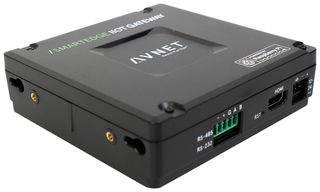IIoT and M2M communications and their role in Industrial Automation & Control System

This brief precis will handle common myths and show a few important discrepancies between the two buzzwords of technology.
In order to provide omnipresent systems that can optimize operational throughput and machine productivity, a panoramic range of smarter sensors, robots, actuators and controllers is connected and incorporated. Industrial Internet of Things (IIoT) and M2M communications solutions both have remote device access as their common core and deliver communication between devices without any human control. The goal is basically the same (achieving connectivity), but the means are different to make it profitable.
What is M2M Communication?
M2M development was crucial to IIoT realization. M2M is essentially point-to-point communication with fixed lines implementing different protocols among devices of specific application and same type. M2M devices accede to requests for enclosed data or automatically transmits the same. These can be various kinds of temperature sensors and motion detectors. An adequately complex monitored machine may employ the M2M module as a modem enabling data transmission. However, the machine with a simple circuit and switch may not show adequately intelligent behaviour, which then is placed in a slave role controlled by the M2M module.
M2M gateway offers interconnection of M2M devices and forwards data gathered from a communications network. The communications network serves as the infrastructure for realising communication between the M2M gateway and M2M end-user application or server. For this purpose, cellular network, telephone lines, and communication satellites can be used as shown in below Figure 2. Programmable Logic Controllers (PLCs) now control M2M communication systems. PLCs are a vital component of supervisory control and data acquisition (SCADA), a supervisory control system created to manage automated, big-scale industrial operations. Standard M2M systems are proprietary and detached from the internet with no provision for broader services, applications, and analytics. M2M systems are thus termed "siloed" or single-use/dedicated technology and do excellent work at controlling a specific industrial process. They, however, cannot share data with a business enterprise’s ERP, PLM, or SCM systems.
Farnell has partnered with many different suppliers like Schneider, Siemens, Mitsubishi, Honeywell, ABB, MulticomPro and more, who produce such broad portfolio of products like PLC’s, HMIs, IIoT Gateways, M2M Gateways etc., to meet several requirements in IIoT& M2M Communication in Industrial Automation & Control System. (For more information please Click here)

Figure 1: Basic architecture of Machine-to-Machine communication
What is Industrial IoT?
The Industrial Internet of Things (IIoT) is a new paradigm for developing valued applications and business capabilities on top of the Industrial Ethernet Network, which completely connects the shop floor. IIoT network connects machines such as industrial robots, machinery and connected sensors that allow for inter-machine communication. Such devices employ various actuators and sensors to send data via the internet. The Internet of Things aka IoT comprises communicating devices used for machine to machine communication. IIoT results in real-time actionable information that helps operators run their factories more efficiently. These systems enable a higher level of integration of business operations resulting in increased profits and reduced costs.
With IIoT and M2M communications, various production processes are integrated employing intelligent devices. This arrangement generates and accumulates interesting industrial data. The Industrial Internet Consortium and Industry 4.0 gather such ideas to the industry, along with focusing on bringing together different production processes with advanced internet-based analytic and computational abilities.
A good example for this layer is an Avnet SmartEdge Industrial IoT Gateway that connects sensors and several other devices to Cloud. One can view the status and control the connected devices from a fully customizable web portal from any internet-enabled location. The gateway is based on the popular Raspberry Pi's Broadcom BCM2837 SoC, a 64-Bit quad-core Arm Cortex-A53 that provides high-performance computing power. (For more information on Avnet SmartEdge Industrial IoT Gateway please Click here)
Above this are the facilities for capturing and analysing a continuous historical record of the process, and tools for planning and scheduling production activities that are passed down to the lower layers for execution. In the case of the IIoT, the applications running against cloud-based storage include applications geared towards industrial enterprises such as planning/scheduling, optimisation and engineering.

Figure 2: Basic architecture of Industrial IoT
M2M Communication v/s IIoT- Main Differences:
The terms IIoT and M2M share common roots as both refer to an identical origin: devices that interconnect to an industrial control system to accomplish a tangible result. IIoT, however, serves crucial capabilities where traditional M2M systems fail. An M2M system is engineered to control an exclusive process, generally an industrial machine or a cluster of interconnected machines. This is accomplished via cellular or wired connectivity using embedded hardware modules and point-to-point communications running a dedicated application. The IIoT systems utilize the internet to dispatch device data to the cloud where multiple services and applications are applied.

Figure 3: Basic architecture of Machine-to-Machine communication
| M2M Communication | Industrial IoT |
|---|---|
| Dedicated | Evolvable |
| Monitoring/Maintenance | Integration/Services |
| Siloed Technology | Open Technology |
| Hardware-focused | Software-focused |
| Structured Data | Unstructured Data |
| Point-To-Point | Cloud (IP-Networks) |
Table: Summary of highlighting differences between M2M Communication and IIoT
IIoT systems enable data to be shared over the enterprise to extract business intelligence for better operations management. The transition from deployments of closed silos to multi-functional open IIoT technologies permits the integration of sensor and device data with other enterprise applications like Big Data and analytics. M2M systems decode problems via machine level or device service improvement while IIoT systems take advantage of Big Data and analytics to reap enterprise-wide improvements.
M2M systems reduce service-linked expenses with remote capabilities like remote diagnostics, updates, and remote troubleshooting to minimize the dispatch of field service engineers to far off-sites. IIoT systems, in contrast, accentuate operational improvements and provide information products as a service through the cloud. In other words, IIoT marks a transition from hardware (like connectivity and devices) to software (like services, actionable knowledge, and data) to boost operations.
M2M vs IIoT: Your Choice:
Your decision pivots on what you want from your device communications technology. No free size exists when it comes to devising networking. Select the most application friendly option.
M2M technology is an informed choice if:
- The application needs point-to-point communication between machines
- Quick scalability is of secondary concern for your network
- The device network is isolated for security reasons
- The application has a limited set of particular machine communication needs that requires quick and reliable execution
- Your application must operate independently of whether or not an Internet connection is available
Conversely, IIoT may be the best option if:
- Your application needs real-time syncing of multiple different devices spanning a networking cloud
- The application needs easy and smooth scalability for a larger population of users and devices
- TYour application must be able to make its devices and data compatible with various standards
- Your devices enjoy access to a quick, reliable Internet connection
- Your network devices need the ability to communicate with multiple other devices simultaneously
Conclusion:
M2M and IIoT are broadly similar. M2M concerns machines, appliances, and smartphones, whereas IIoT concerns cyber-based physical systems like sensors. M2M concentrates on the maintenance level, like alerting manufacturers concerning a possible machine defect, whereas IIoT is used to integrate vast systems. M2M is hardware-centric, while IIoT is software-based.










